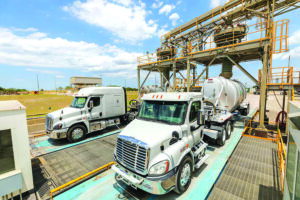
Under the agreement, Eco Material will harvest approximately 600,000 tons of landfilled ash per year from the plant in Putnam County, Georgia.
Eco Material Technologies, the nation’s leading producer of sustainable cementitious materials (SCMs) and near zero carbon cement replacement products, reached an agreement with Georgia Power during mid-October to harvest millions of tons of landfilled ash from Plant Branch, a coal-fired power plant that retired in 2015.
Under the agreement, Eco Material will harvest approximately 600,000 tons of landfilled ash per year from the plant in Putnam County, Georgia. The effort will remove and beneficially use more than 8 million tons of fly ash, doubling the production of the two companies’ partnership, over a 15-year term.
“Our partnership with Georgia Power through the Plant Branch project, should be a model for the rest of the country on how to efficiently re-use stored coal ash in a way that positively benefits the construction industry, local communities and the environment,” said Grant Quasha, CEO of Eco Material Technologies.
The Branch project will be the second fly ash harvesting plant in of Georgia, following an announcement by Eco Material and Georgia Power last year with Plant Bowen, and will utilize Eco Material’s in-house ES EcoSystem Efficient Carbon Offloading technology. Construction of the fly ash harvesting plant at Plant Bowen has already begun and is expected to begin harvesting ash for processing by 2024.
The ES EcoSystem Efficient Carbon Offloading technology is a proprietary solution that offers a lower-cost and greener process to reduce high carbon content in landfilled and ponded coal ash, bringing it up to required specification for use in concrete and other building materials.
The ash from Plant Branch will be used in concrete blends to repair and construct bridges, roads, and buildings in Georgia and Florida and will reduce dependance on imported materials with a proudly Made in the USA recycled product.
The ash Eco Material is harvesting from Plant Branch has been proven to enhance the strength, impermeability, and durability of concrete. In common practice, the material will replace 20%-25% of Portland cement in concrete mixes. Portland cement, and the concrete industry as a whole, currently account for approximately 8 percent of global carbon emissions.
Eco Material and Georgia Power have worked together for more than 40 years to develop new approaches to improve environmental stewardship while offsetting both cost and carbon footprint in cementitious materials. Critically, Eco Material and Georgia Power are focused on economically addressing the issues around coal ash in a manner that will reduce waste, reduce emission and reduce costs to Georgia Power’s rate payers.
“At Georgia Power, our team across the state is committed to meeting the energy needs of our customers today, while investing in innovative ways to continue to deliver clean, safe, reliable and affordable energy for future generations of Georgians,” said Jennifer McNelly, vice president of Environmental Affairs for Georgia Power. “We work every day to be innovators in the industry, reduce our environmental impact, and find ways to deliver additional value for our customers and, with this latest beneficial reuse project at Plant Branch, we are doing just that.”
The Branch project is being facilitated with assistance from the Putnam Development Authority (PDA), which has provided incentives to Eco Material to encourage “fast track” development of the Branch project. “The Putnam Development Authority is proud to be able to assist in adaptive reuse of the Plant Branch site and resources by Eco Material,” said Walter C. Rocker, chairman of PDA. “Eco Material’s plan to work with Georgia Power to bring new, high-quality jobs and significant investment to our community represents a turning point toward reinvigorating the former Plant Branch site as an economic driver for our community.”
Eco Material is building a new plant onsite to harvest ash at Plant Branch with the plant’s completion expected in under two years. In addition to construction and other temporary jobs, more than 30 full-time jobs will be created for operation of the facility.


